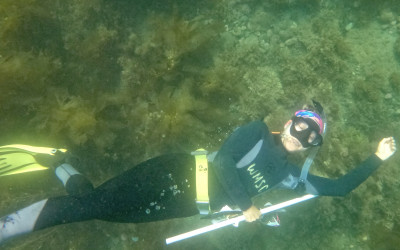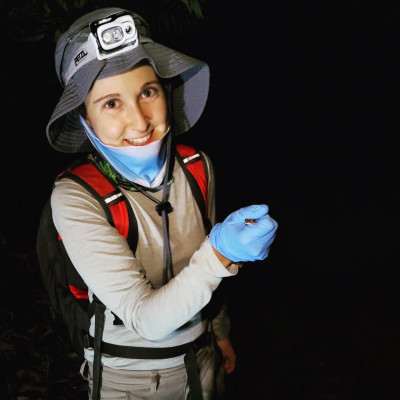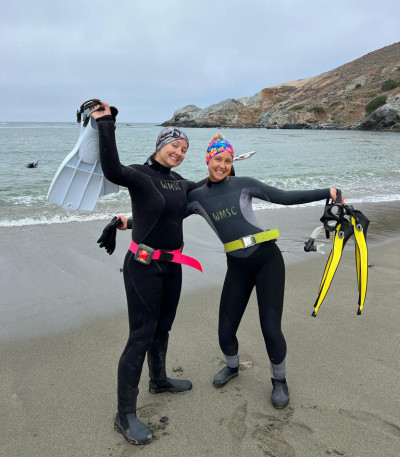Flora Coden is a student in the Master of Advanced Studies program in Marine Biodiversity and Conservation (MAS MBC) at Scripps Institution of Oceanography at UC San Diego. Coden is from Oakland, Calif., and attended UC Davis where she received a bachelor's in environmental policy analysis and planning with a minor in communication. At Scripps, she is volunteering in the Burton Lab and Vernet Lab and uses cutting-edge technology such as environmental DNA, or eDNA, to investigate the impacts of climate change and marine pollution on the ecology of marine environments.

explorations now (en): Why did you choose to attend Scripps?
Flora Coden (FC): A few years after graduating college, I was working as an environmental consultant, permitting utility-scale solar and wind farms. I was sitting at my desk reading a biological resources technical report and thought to myself how much I would love a job conducting field surveys rather than just reading about them. Within a few months, I switched jobs and was conducting field surveys. I learned how to distinguish birds by sight and call, identify plants using tweezers and a microscope, and create Keyhole Markup Language Zipped (KMZ files) — which express geographic information in internet-based maps — of Stephens’ kangaroo rat burrows I discovered. The more I learned about the natural world, the more I wanted to continue to learn. Living near the water in San Diego for the past seven years, I’ve enjoyed the ocean by stand-up paddleboarding, surfing, and tide pooling. But it wasn’t until I became SCUBA certified in 2022 and traveled to Bali, Cozumel, and Tulum on SCUBA trips that I decided to focus on marine research for my career. I had my eye on Scripps ever since moving to San Diego, and after gaining experience from other jobs and industries, I decided that going back to school at Scripps was my next step.
en: What are you researching at Scripps?
FC: I am currently in the winter quarter taking courses such as biostatistics with R, a programming language; marine GIS (Geographic Information Systems); marine mammal biology; and water pollution. I am also volunteering in two labs on campus: the Burton Lab where I extract environmental DNA, or eDNA, from water samples taken in La Jolla, and the Vernet Lab where I filter and categorize microplastics from gut contents of deceased seabirds. I am also working with California Cooperative Oceanic Fisheries Investigations (CalCOFI) by analyzing eDNA data from their cruises to compare the efficiency of different eDNA sampling protocols. I am especially interested in how climate change and marine pollution are changing the ecology of marine environments and how we can develop research methods to quantify these changes to protect our ecosystems. I want to use my time at Scripps to learn technical skills that will allow me to conduct and convey meaningful conservation research.

en: How did you become interested in science and your field of study?
FC: I have always loved being in nature and exploring the outdoors, but it was a hobby that I did on the weekends or after getting home from work. In 2021, I decided to take a two-month sabbatical from my job to join Field Projects International, a program that conducts conservation research in the Peruvian Amazon jungle. I learned research and lab techniques through this program, including conservation genetics, field sampling methods, and the use of technology, such as telemetry, camera traps, and GPS trackers. After completing the program, I decided that I wanted to pivot my career toward research rather than consulting.
en: What’s life like as a Scripps student? Describe a typical day.
FC: Since my MAS MBC program is only one year, I am making the most of the time I have here, which includes taking 14 units, auditing a four-unit class, and volunteering in multiple labs. A typical day includes waking up early, getting in a quick beach run or surfing, then commuting to campus for class. In between classes, I do volunteer work in different labs depending on the day. On Tuesdays in the Burton Lab, I collect water from the end of the pier, extract eDNA using a kit, and if time permits, conduct PCRs — which are Polymerase chain reactions — a lab technique to amplify DNA sequences to confirm the results before sending for sequencing. On Thursdays in the Vernet Lab, I filter the stomach contents of seabirds, such as the Northern fulmar. I pick out the microplastics and categorize them using a microscope. After returning home in the evenings, I make sure I have time and energy left to take my eight-pound chihuahua terrier, Pebbles, to the beach for a long walk.
en: What’s the most exciting thing about your work (in the field or in the lab)?
FC: First and foremost, it’s exciting to meet so many impressive, passionate researchers and learn about their projects! In my particular work, I am excited about the use of eDNA, which is still a fairly new technology in marine science and is being used by researchers in many ways. I am excited to learn more about the ways that eDNA can be used in marine conservation research, as well as ways to refine the methods and protocols to increase the efficiency and efficacy of the tool.

en: Are there any role models or mentors who have helped you along the way?
FC: Ron Burton has been instrumental in providing a way for me to work in the lab directly with eDNA. He allocates time towards teaching lab protocols and field sampling methods and is also fun to just sit and chat with! Nastassia Patin with CalCOFI has also generously volunteered time explaining ongoing eDNA projects that her group is working on, as well as helping me learn data analysis methods.
en: What are some of the challenges you face as a student?
FC: I gained important, real-world experiences having been in the workforce for nearly nine years before joining the MAS MBC program. But it also required a big transition for me to go back to school. Additionally, narrowing down my study focus area has been a challenge as I am interested in so many aspects of marine science. Overall, I’m incredibly happy to be a graduate student here at Scripps!
en: What are your plans post-Scripps?
FC: Immediately after graduating, I plan to take a SCUBA trip somewhere tropical for a couple of weeks. After that, I plan to get a job in marine conservation that combines fieldwork, lab work, report writing, and data analysis. I hope to have a more definitive answer to this question in a couple of months.
You can find Coden on Instagram @flo.coden.



